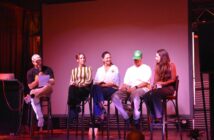 Somewhat surprisingly, for a man who’s the president and chief creative officer of the massive behemoth that is the Time Warner Global Media Group (oh, and he’s also the senior vice president of Time Warner), Mark D’Arcy exudes calm and charm. And, with a silver tongue and a penchant for strange magazines like this, he seems like your quintessential creative director. The strange thing is he’s actually working for a media company and he’s at the forefront of what he sees as a move towards media-led creativity in marketing.
Somewhat surprisingly, for a man who’s the president and chief creative officer of the massive behemoth that is the Time Warner Global Media Group (oh, and he’s also the senior vice president of Time Warner), Mark D’Arcy exudes calm and charm. And, with a silver tongue and a penchant for strange magazines like this, he seems like your quintessential creative director. The strange thing is he’s actually working for a media company and he’s at the forefront of what he sees as a move towards media-led creativity in marketing.
Prior to joining Time Warner, the huge media company that owns television networks, filmed entertainment companies and an array of publishing enterprises, D’Arcy worked for more than 15 years as a writer and creative director in advertising agencies around the world. And he was back in the homeland recently to pick up his World Class New Zealand award (check it out on the New Zealand networking organisation Kiwi Expats Abroad site),for his services to the creative industries.
Back in 2004, Time Warner appointed him to the newly-created position of chief creative officer to be a kind of bridge between the company and its biggest advertisers, like Unilever and GM, in an attempt to inject more creativity into the services they provided.
“Don’t quote me on it, but I think about 22 percent [of Time Warner’s income]is ad revenue. So these big companies want relationships and they want to figure out the best way to use their money across the portfolio.”
D’Arcy claims to like simplistic metaphors, so he describes the current media mix as a recipe, where everything’s an ingredient and each aspect adds to the whole. And after a long career in advertising, he’s come out with a strong dislike for “extremism”: claiming ‘*insert particular media channel here* is dead’ may be good for panel discussions, but it’s not how the real world works. He says there are too many complexities involved to look at it in such a way. Or, in more simplistic metaphorical terms, the measurements may change, but the flour will never completely take over the butter. Or the eggs, for that matter.
For him, his job is all about creating content for advertisers that adds utility for consumers, like the Global Diabetes Handprint campaign in conjunction with Johnson & Johnson, which encouraged people to upload pictures of words they had written on their hands for charity, or Nike’s use technology that sends data from the running shoe back to the computer. It isn’t an ad, he says, but it’s a “dimension”, where everything does a different job to add value to the brand. In this way, it’s the client becomes the integrator.
“I think people are really smart. And I think they know when integration is cumbersome,” he says. And these days, it doesn’t serve the advertiser if it doesn’t serve the customer in some way.
D’Arcy believes Time Warner is fairly unique because, unlike most other media agencies, it has invested in creatives. He thinks creative people have largely been removed from media and, “traditionally, ad agencies aren’t very good collaborators”. But media agencies have become increasingly important when it comes to planning and campaign strategy and, in Time Warner’s case, where the creative will end up is increasingly informing the creative itself.
“They think of a media company as a creative enterprise. And it’s what clients are needing. They’re looking for ideas and people who can create those ideas . . . The media marketplace has become an idea marketplace. It’s less about numbers, and more about solving problems.”
He abides by the ‘one point for an idea, nine points for execution’ mantra. So, instead of having an idea first, he says Time Warner’s approach is to ask the client about the challenge, find out how to solve that challenge and build everything around the challenge by finding out what platform in its portfolio fits.
“How do we make all these aspects work together? We think the best additive value a company like Time Warner can have is creative. All of our expertise is based on making things. So it’s a couture solution; we hand-make solutions for our client.”
Put simply, he says it’s media-led creativity. And while he admits it might seem like semantics and people could rightly call bullshit on it, but the proof is in the pudding (check some of the work on Art of the possible).
Of course, we live in uncertain and experimental marketing times. But D’Arcy thinks the diversity of digital opportunities is a great thing for the industry that “keeps enriching the business, in ways large and small”.
“It’s a really cool time. But you have to be very comfortable with the phrase ‘I don’t know’. People are consuming our content more than ever. And we also have incredible knowledge of the consumer.”
While he says technology can be – and has been – democratised, talent cannot, which is why, despite the amount of ridiculously good user-generated content that he finds online (this, for example), he thinks there will always be a need for Hollywood – and for companies like Time Warner.
Social media, in particular, seems to be the most mysterious, yet exciting, marketing realm at present. But he says one of the big things people are talking about on social media is what’s happening in the media (CNN has a massive relationship with Twitter). This, of course, is good for his company and overall he says the company sees more good than bad coming from social media.
Everyone’s thirsty for measurement, however, but when asked how a huge company like his measures social media success, it’s back to ‘I don’t know.’ Hollywood has always used the box office as a measure, but with so many more channels and more subjective ways to measure success, he says it becomes exponentially more complex.
It’s often claimed that social media is more engaging and authentic than traditional advertising messages. It’s the conversation, not the broadcast (according to one study, 18 percent of young whippersnappers trust traditional ad messages compared to 60 percent if a commercial message comes from a friend). But, despite the assertions about additional engagement, he says it’s not a new marketing theme. In the old days, he says TVCs still wanted to engage through their entertainment messages. What’s different is that these days companies have so many more ways to listen.
D’Arcy, who lives in New York with his family, still has plenty of connections in the New Zealand ad industry, but hasn’t spent enough time here to pass too much judgement (“Avoid is the wrong word,” he says). Back in 2003 he moved to Waiheke Island and wrote a children’s book that sold 50,000 copies, cementing the fact that he’s just one of those sickeningly successful people who can do everything. But there just wasn’t really anything in a business sense that was drawing him here. Now, however, he is the vice president of the Friends of AUT chapter in New York and has also spoken at some KEA events there, so his Kiwi connection remains relatively strong from afar.
From the outside looking in, he says there seems to be a huge amount of retail advertising and ads from the government telling people to slow down on television. And while he still thinks New Zealand ranks highly in terms of advertising creativity, he doesn’t think we should qualify our success. We should just be judging talent because good work is good work.
“I’ve always been very loathe to do things on a per capita basis. New Zealand is not as small as we make out. It’s a proper country, four million people, which is about the same as some of those ‘Nordicky’ countries, but we sometimes adopt the demeanour of an atoll, almost like the boat comes once a week.”
He says, if anything, the theme of the day from the speakers at the World Class New Zealand awards was for Kiwis to “dream a little bigger”. And he says if Crispin Porter and Bogusky can be one of the world’s most awarded agencies after setting up in Miami and then moving to Boulder, Colorado, it’s not right that we’re still shocked when New Zealand agencies do well.




